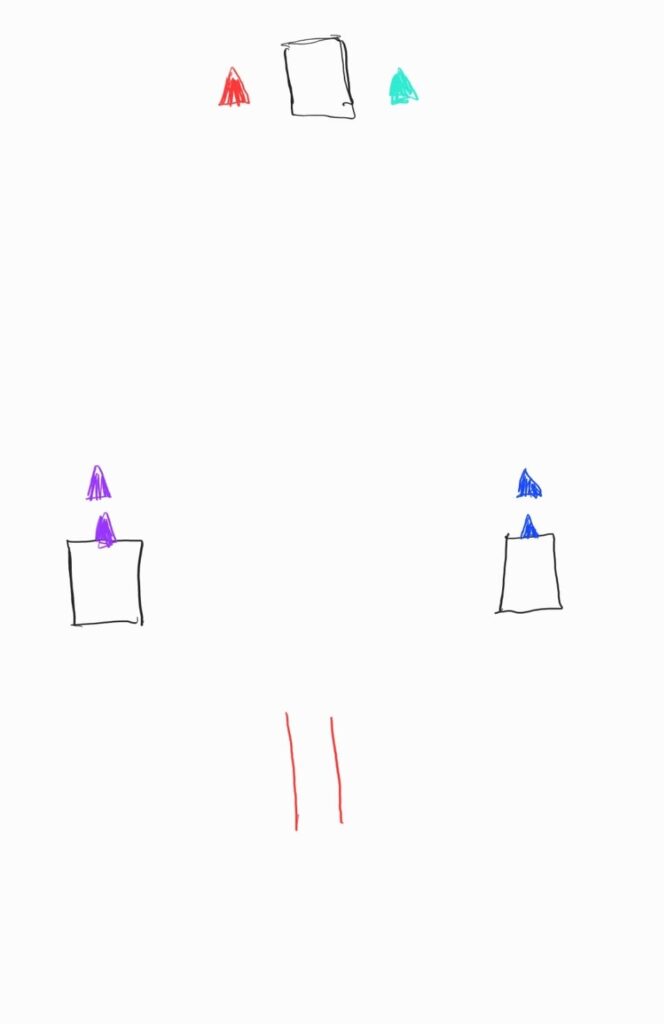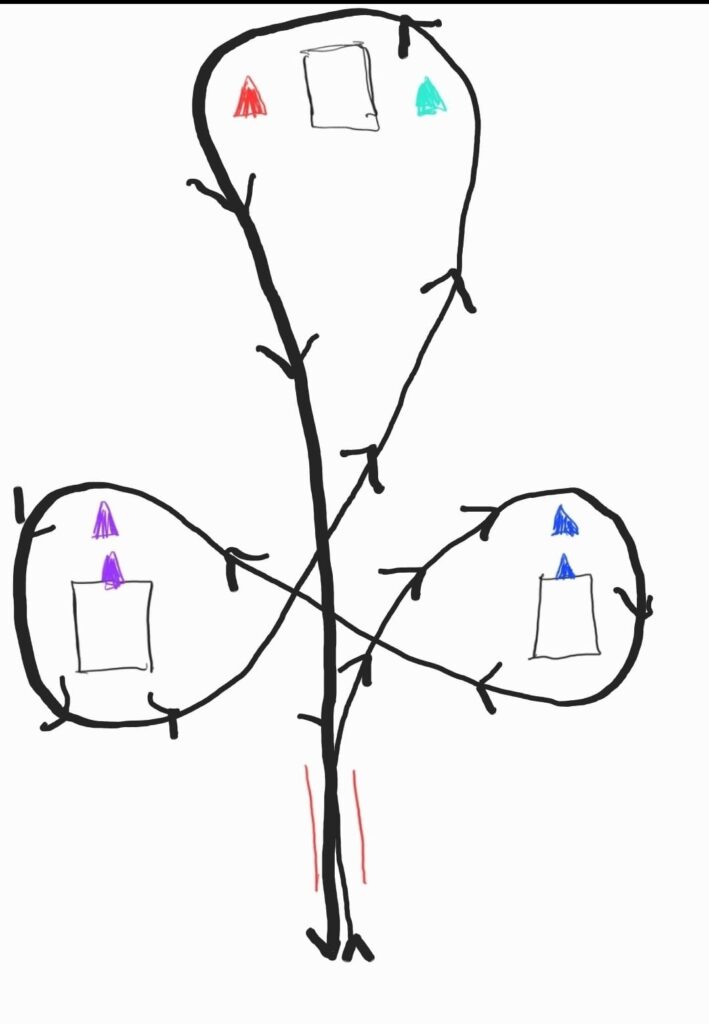In this discussion, we delve into the “whys” behind why you may want to add on additional visual support when introducing and progressing students within the barrel/three leaf clover pattern. We will be looking at a more “learner friendly” way to set up and introduce this common pattern.
By discussing the barrel pattern and adding in visual support we can also shed light on the importance of an instructor having a thoughtful layout of the skill, pattern, and/or arena figure they are teaching. Sometimes instructors are hesitant to deviate away from the “traditional” format of a pattern or arena figure….because heaven forbid we alter something “traditional”. Deviating from what a pattern “should be” when students are first learning the pattern may actually tremendously aid students understanding and riding the “traditional” format in the long run.

Visual added: 2 ground poles
- Students not knowing where to start or end (the barrels are really just a triangle that looks the same from every side if you dont “see” the clover leaf you need to draw)
- Students not completely finishing pattern
- Students getting “lost” to first barrel because start line is off.
- Marks the start and end point of the pattern
- Helps students find the middle so they can better orient to the first barrel they will be riding to
- Gives a specific visual thing for them to look at going around the last barrel
Visual added: Cones on ground NEXT TO barrel
- Confusion of not knowing what side of barrel to ride towards
- Not knowing how to get the barrel on their left or right side, struggling with left/right or inside/outside to orient
- Getting too close to barrel
- Not looking ahead/knowing where to look next in pattern
- Marks the side of the barrel they need to ride by to do the correct direction of turn. (Notice how the 3rd barrel has a different color on each side)
- Are different colors to help students “see” and remember the order to ride the barrels
- Gives a visual of how far away to be from the barrel when turning. These can be adjusted out for horses who need bigger turns.
- Gives a visual and concrete item to relate to the “left” or “right” side of their body.
- Helps students understand what/how “turn right around barrel” or “turn left around barrel” happens.
- Gives students something to push or open rein towards to help with opening rein.
- Creates a colored item for students to name and look at while turning around previous item.
Visual added: Cones ON the barrels
- Difficulty with a long, “strong” turn to get all the way around barrel
- Student gets “lost” once cones on ground are gone (after progression of taking the ground cones away)
- This will be the “progression” in following lessons when the cone on the ground is taken away.
- Gives them something to push or open their rein towards to help with opening rein.
- May be a better height for the students to look at than the cone on the ground if they are looking down.

Final thoughts and tips
As instructors, it’s crucial to recognize that the initial setup of a pattern may evolve as students progress and learns to ride the pattern how it “traditionally” is set up. Removing visual and verbal support can be a part of this progression. Additionally, thoughtful additions to the pattern should have a clear purpose in resolving issues without introducing confusion.

Remember these key points when thinking about how to set up a pattern to optimize communication and your student’s learning:
- Progression: Evolve patterns by reducing visual, verbal, and/or physical support as students advance.
- Orientation: Add elements to help students better orient themselves in the pattern and and mentally “see” where they need to ride.
- Purposeful Additions: Ensure that any additions serve a clear purpose in resolving or preventing issues.
- Common Sticking Points: Identify and address common challenges by adding support as needed even if it is not part of the “traditional” format of the pattern.
Inclusive Application
It’s important to note that the discussion above applies equally to both adaptive/therapeutic and traditional riding lessons. The principles outlined here contribute to instruction that optimizes the learning experience for all students and meets them where they are no matter what unique physical, cognitive, or emotional needs they may have.
Want to DIG DEEPER into this topic?
Check out the recorded presentation on “Barrel Pattern- Optimizing Communication & Student Progression” in the Intuitive Instructor Club and earn 80 minutes of continuing education!
Get immediate access to this content and 150+ other educational videos created just for adaptive/therapeutic riding instructors and other EAS professionals.

About the author: Saebra Pipoly of Arizona owns and operates Hoof Falls & Footfalls, LLC, which provides resources to adaptive/therapeutic riding instructors. She grew up living and breathing everything horse and has been immersed in the Equine Assisted Services (EAS formerly EAAT) industry since 2008.
Saebra has a passion for building up other instructors to be the best they can be so they can go out and impact countless lives by teaching their students and mentoring other instructors. Her focus is to pass on “how” to implement solid teaching techniques in every lesson, have a mindfulness of our equine co-workers, and understand the importance of horse and human mechanics and interactions; all these pieces come together to enable instructors to provide quality, safe, and engaging lessons lessons that keep students and horses happy and healthy.
Saebra is a CHA-IRD Master Instructor and Assistant Certifier as well as a PATH Intl. Advanced TRI, CTRI, ESMHL, Associate CTRI Faculty, and a recognized Mentor. In addition to her equine background she holds degrees in Psychology and Family & Marriage Development and has been adjunct faculty for equine programs at two colleges.
Contact her at Saebra.p@HoofFallsandFootfalls.com


